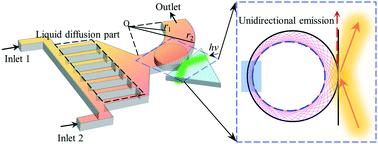Our official English website, www.x-mol.net, welcomes your feedback! (Note: you will need to create a separate account there.)
Optofluidic gradient refractive index resonators using liquid diffusion for tunable unidirectional emission.
Lab on a Chip ( IF 6.1 ) Pub Date : 2020-06-12 , DOI: 10.1039/d0lc00395f H L Liu 1 , Y F Zuo , X Q Zhu , Y Yang
Lab on a Chip ( IF 6.1 ) Pub Date : 2020-06-12 , DOI: 10.1039/d0lc00395f H L Liu 1 , Y F Zuo , X Q Zhu , Y Yang
Affiliation

|
Resonators have been used in a wide range of fields, such as biochemical detection and microscale lasers. In recent years, optofluidic resonators have attracted a significant amount of attention owing to their unique liquid environments. Liquids containing biochemical samples can be designed to pass through the ring resonators or to directly form droplets, for sample sensing. Liquid diffusion is an important property in optofluidic applications, such as gradient refractive index lenses and waveguides. However, liquid diffusion has not been used in the study of optofluidic resonators, for both possible sensing characteristics, and unidirectional emission that is mostly acted as light sources. Here, we introduce a gradient refractive index profile formed by liquid diffusion in annular channels into a circular resonator, forming a gradient-index resonator with a tunable unidirectional emission. For both simulations and experiments, the squeezed and non-rotationally symmetrical light intensity profile was first obtained in a circular resonator. The squeezed light profile enables unidirectional emission in circular resonators, which is difficult to achieve in conventional ones. The squeezed light profile and unidirectional emission are determined by the refractive index difference of the liquids used, the dimension of the circular channels, and the working wavelengths. In experiments, different dimensions of bending radii were demonstrated and a tunable squeezed light intensity profile and unidirectional emission were exhibited. Interestingly, the squeezed coefficient of light, which was about 1.8 for a bending radius of 100 μm, enabled emission with a divergence angle as small as 14 degrees, which could be used for laser emission applications in the future. This work reveals the significant potential of the novel liquid gradient refractive index resonator, which provides a practicable approach for optofluidic resonator emission applications and also has potential for use in optofluidic sensing based on the squeezed light profile.
中文翻译:

使用液体扩散的可调谐单向发射光流体梯度折射率谐振器。
谐振器已在广泛的领域中使用,例如生化检测和微型激光。近年来,光流体谐振器由于其独特的液体环境而引起了极大的关注。可以将包含生化样品的液体设计为通过环形共振器或直接形成液滴,以进行样品感测。液体扩散是光流体应用中的重要属性,例如梯度折射率透镜和波导。然而,由于可能的感测特性和主要用作光源的单向发射,在光流体谐振器的研究中并未使用液体扩散。在这里,我们介绍了由液体在环形通道中扩散到圆形共振器中形成的梯度折射率分布,形成具有可调单向发射的梯度折射率谐振器。对于仿真和实验,都首先在圆形谐振器中获得了压缩且非旋转对称的光强度曲线。压缩的光分布使圆形谐振器能够单向发射,这在常规谐振器中很难实现。压缩的光分布和单向发射取决于所用液体的折射率差,圆形通道的尺寸以及工作波长。在实验中,演示了不同尺寸的弯曲半径,并显示了可调节的压缩光强度曲线和单向发射。有趣的是,对于100μm的弯曲半径,压缩的光系数约为1.8,支持发散角小至14度的发射,将来可用于激光发射应用。这项工作揭示了新型液体梯度折射率谐振器的巨大潜力,它为光流体谐振器发射应用提供了一种可行的方法,并且还具有基于压缩光分布的光流体感测中使用的潜力。
更新日期:2020-07-29
中文翻译:

使用液体扩散的可调谐单向发射光流体梯度折射率谐振器。
谐振器已在广泛的领域中使用,例如生化检测和微型激光。近年来,光流体谐振器由于其独特的液体环境而引起了极大的关注。可以将包含生化样品的液体设计为通过环形共振器或直接形成液滴,以进行样品感测。液体扩散是光流体应用中的重要属性,例如梯度折射率透镜和波导。然而,由于可能的感测特性和主要用作光源的单向发射,在光流体谐振器的研究中并未使用液体扩散。在这里,我们介绍了由液体在环形通道中扩散到圆形共振器中形成的梯度折射率分布,形成具有可调单向发射的梯度折射率谐振器。对于仿真和实验,都首先在圆形谐振器中获得了压缩且非旋转对称的光强度曲线。压缩的光分布使圆形谐振器能够单向发射,这在常规谐振器中很难实现。压缩的光分布和单向发射取决于所用液体的折射率差,圆形通道的尺寸以及工作波长。在实验中,演示了不同尺寸的弯曲半径,并显示了可调节的压缩光强度曲线和单向发射。有趣的是,对于100μm的弯曲半径,压缩的光系数约为1.8,支持发散角小至14度的发射,将来可用于激光发射应用。这项工作揭示了新型液体梯度折射率谐振器的巨大潜力,它为光流体谐振器发射应用提供了一种可行的方法,并且还具有基于压缩光分布的光流体感测中使用的潜力。



























 京公网安备 11010802027423号
京公网安备 11010802027423号